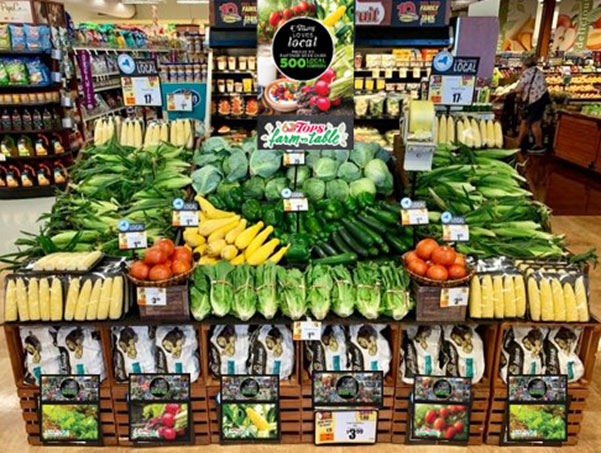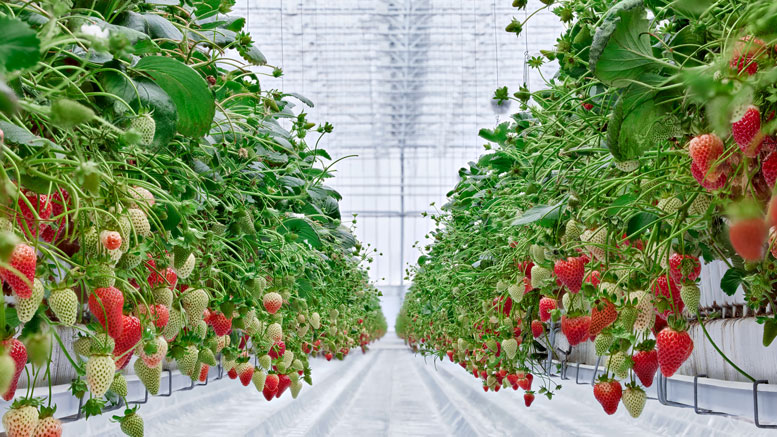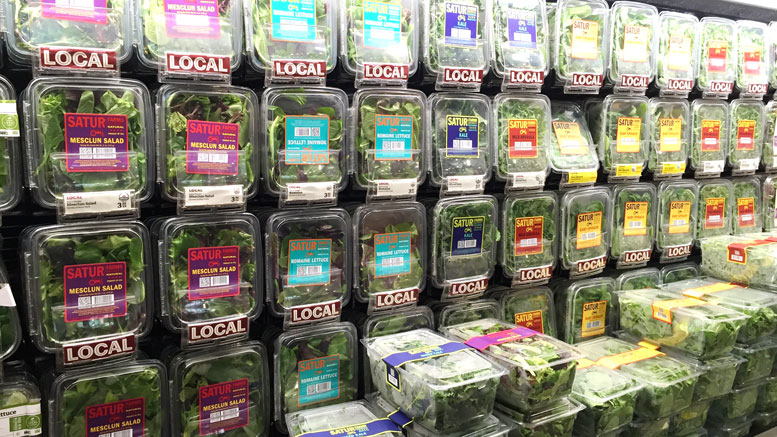I Love New York’ Produce!
August 23, 2023 | 11 min to read
New York State, renowned for its apples, boasts a rich agricultural history and diverse geography conducive to a wide variety of crops due to its four-season climate. With over 600 commercial apple growers, New York is the second-largest apple producer in the U.S., offering varieties like Gala and Honeycrisp. Innovations in greenhouse technology extend the growing season, while programs like NYS Grown & Certified promote local produce that fresher and more sustainable, benefiting retailers and consumers alike.

Best known for its apples, New York State offers a bounty of regional and seasonal products that connect with consumers and offer close-to-market freshness.
ONLINE EXCLUSIVE
New York State has a long legacy of produce supply dating back to colonial days.
“The history of New York agriculture goes as far back and even before the American Revolution,” says Richard A. Ball, commissioner of the New York State Department of Agriculture and Markets in Albany, NY. “In fact, the Schoharie Valley was known as the breadbasket of the Revolution because we raised a lot of the crops that fed Washington’s troops.”
New York’s diverse geography and ideal climate grant it an advantage in producing apples and other crops. The state’s diverse geography, which includes the Hudson River Valley, the Finger Lakes region, and the fertile soil of Long Island, provides a range of microclimates suitable for different types of crops, explains Marcus Albinder, operations manager at Hudson River Fruit Distributors in Milton, NY.
“New York’s four-season climate, with cold winters and warm summers, also allows for a variety of fruits and vegetables to thrive.”
One of the state’s microclimates, the North Fork of Long Island, is moderated by the waters of the Peconic Bay and Long Island Sound so field harvest can extend from May through December, explains Paulette Satur, chief executive of Satur Farms in Cutchogue, NY.
“The sandy loam soil with its high mineral content adds intense flavor to our greens, particularly our wild arugula,” she says. “This region is so conducive to agriculture, evidenced by the legacy of many farms remaining in the same generational families since the land was granted to them at the inception of our nation.”
PLENTY OF OPTIONS
New York offers a wide variety of fresh fruit and vegetable products: apples, beans, carrots, cherries, sweet corn, grapes, peaches, potatoes, greens, cauliflower, squash, peppers, pumpkins and tomatoes, to list just a few. In fact, according to Commissioner Ball, the state produces approximately 32 vegetable commodities with significant production.
“Most of these products hit shelves during the summer or fall,” says Dave Hartmetz, produce manager for Hegedorns Market in Webster, NY.
Hannaford Supermarkets, based in Scarborough, ME, operates 186 stores and works strategically with local New York partners, according to Kimberly Kuusela, local merchandising specialist. “These partnerships help us provide more local foods to customers of New York,” she says.
New York is fantastic for produce items because of its four seasons, adds Brandon Bentley, category business manager for vegetables at Tops Friendly Markets in Buffalo, NY, with 154 stores.

“We emulate the Florida heat in July, Santa’s snow in December, and the falling colors of autumn in September — each with its own food style, from hearty to indulgent and fresh to vibrant. Even the snow birds need their New York State apples down in Florida for Thanksgiving apple pies.”
Wholesaler D’Arrigo New York in Bronx, NY, pulls a good amount of product from New York state, according to Gabriela D’Arrigo, vice president of marketing and communications, although the majority handled is apples. “We work with different growers to help with logistics, since many of these growers are in very rural areas.”
With more than 600 commercial apple growers across the state, New York is the second-largest apple producer in the U.S., explains Hudson River Fruit’s Albinder. The apple harvest in New York typically starts in late summer and peaks between September and October.
Albinder says New York growers cultivate over 20 varieties of apples, such as Gala, Honeycrisp, Macs, Fuji, Golden Delicious, SnapDragon, RubyFrost, Evercrisp, Pink Lady and more.
Sweet corn is the biggest crop for Turek Farms/Cayuga Produce in King Ferry, NY. “We also grow cabbage, summer squash, winter squash, broccoli, Brussels sprouts, pumpkins and cauliflower,” says Jason Turek, owner. “Our harvest season normally starts in early July and we finish shipping everything around the first of December.”
Crops at Satur Farms really start rolling off the fields by June. “We harvest baby leaf crops, such as wild arugula, baby spinach, spring mix and baby kale, beginning in early May, but by June, they are joined by our veg, including baby bok choi, frisee, baby lettuce heads, mature kale, Swiss chard, and herbs cilantro, chervil and parsley,” says Satur.
YEAR-ROUND POTENTIAL
Investments in greenhouse technology have created some unique opportunities for New York produce. Hannaford receives year-round regional product through its relationship with Mastronardi Produce of Kingsville, Ontario, Canada, with New York and Maine greenhouse programs.
“Through our work together, we are now able to offer greenhouse, New York-grown strawberries in the off-growing season to not only our New York based customers, but throughout our 186-store network,” says Kuusela.

PHOTO COURTEY MASTRONARDI PRODUCE
Mastronardi grows several SUNSET and Backyard Farms items throughout the year in its 60-acre, high-tech greenhouse located in Oneida, NY. “Even in the middle of a New York winter, consumers can enjoy our delicious WOW Berries strawberries, our award-winning Bombs tomatoes, tomatoes on the vine, and fresh English cucumbers,” says Peppe Bonfiglio, vice president of sales.
Gotham Greens operates three hydroponic rooftop greenhouses in New York City, primarily growing leafy greens and herbs, including varieties such as butter lettuce, romaine, green and red leaf, basil and more.
“We grow and deliver fresh, high-quality, longer lasting, and delicious salad greens year-round to our customers,” says Viraj Puri, co-founder and chief executive at Gotham Greens in Brooklyn, NY.
Gotham started as a single rooftop greenhouse in Brooklyn and has grown to become one of the largest greenhouse lettuce producers in North America, according to Puri.
“This year, we will bring our footprint to more than 40 acres of hydroponic greenhouses at 13 locations in nine states,” he says. “While our farms are unconventional, so is our commitment to taste, quality and sustainability.”
PUSHING PROGRESS
New York is famous for advances in apple varieties, but that innovation extends into many other products, maintains Commissioner Ball. “Cornell’s Geneva Experiment station (now called Cornell Agritech) encompasses hundreds of acres of experiments on all kinds of produce,” he says. “Not just apples, but vegetables, grapes, and corn.”
Satur Farms is constantly trialing new varieties. “We are always comparing them in quality and flavor to those we have historically grown,” says Satur.

PHOTO COURTESY SATUR FARMS
New York State fruit growers have been fortunate to have the Cornell ag experiment station working to develop new apple varieties for the world to try, says Albinder of Hudson River Fruit.
“SnapDragon and RubyFrost are two of the newer apple varieties developed by the station that have gained popularity among consumers for their unique flavors and textures,” he says. “Retailers should promote these new varieties to customers who are looking for new and interesting flavors, while also continuing to promote traditional favorites such as Honeycrisp, Gala and Fuji.”
There’s been a big shift in new apple varieties and consumer perception, explains Austin Fowler, co-owner and chief operating officer of Fowler Farms in Wolcott, NY. “Consumers like a more firm, sweeter fruit,” he says. “Newer varieties such as SnapDragon have been a real hit.”
Cornell is also bringing back some of the heirloom varieties, states D’Arrigo. “We are in communication with the university and industry to find out what we can do to help push those varieties in the market and what else is needed in the marketplace,” she says.
Innovation is also at play in packaging, as apples shift toward pouch bags and sustainable materials. Tenley Fitzgerald, vice president of marketing for Yes! Apples in Glenmont, NY, relates Yes! Apples has launched updated paper totes made from recyclable and compostable paper, reducing reliance on plastic packaging.
“Our poly plastic bags are now made with up to 5% less plastic, while our cardboard boxes are fully recyclable,” she says.
VALUING LOCAL
Availability of New York produce benefits retailers on multiple fronts, including consumer interest as well as freshness and cost.
“We love local,” says Tops’ Bentley. “I love that when you walk into your local Tops neighborhood grocery store, you know what farm your produce comes from. I love talking with the local farmers about their passion for what they grow. I love showing our customers all the local things from farms right around ‘their’ corner.”
Store managers and department managers at Hannaford stores have direct relationships with New York farmers and local vendors and receive direct deliveries from them.
“We go outside the industry norm because it’s important to our customers and it’s good for our communities,” says Kuusela. “We’re aware of the positive impact we have on local businesses, our communities and our environment. Plus, being able to offer New York state produce at our New York retail locations means customers get better quality and longer shelf life with produce that is farm-to-fridge often within 24 hours of being picked.”
Indeed, New York producers boast about the farm-to-shelf timeframe. Turek points out the advantage of being close to markets. “We can pick, pack, cool and ship produce picked in morning to arrive at a distribution center in the Northeast that evening,” he says. “There’s really no time of year for a Northeast retailer where product can be fresher than this.”
At Gotham Greens, the goal is to “deliver fresh produce within a day’s drive from our greenhouses to 90% of our customers,” says Puri. The New York-grown products can be found throughout the New York Tri-State area.
Mastronardi’s New York-grown fruits and veggies are delivered fresh from greenhouse to grocer within a few hours, states Bonfiglio. “That means fresher, more flavorful produce for New Yorkers and fewer CO2 emissions as well.”
“Growing locally also means we know exactly where our food comes from,” he adds. “We were the first produce company to introduce product traceability back to the farm — our produce is identified at the greenhouse with a code so we know exactly where it came from and when it was picked.”
Another major benefit for Tops produce departments is the recognition of the New York farms by the shopper communities, explains Bentley. “Customers come in and they know those farms,” he says. “They drive by those farms. Having New York growers adds a huge connection point with the consumer.”
BACKED BY SUPPORT
New York produce is supported by a triad of government, organization and company promotion opportunities. The New York state government operates the statewide NYS Grown & Certified program. Commissioner Ball explains NYS Grown & Certified is the first statewide, multi-faceted food certification program to help consumers identify local, safely-handled, and environmentally responsible agricultural products.
The NYS Grown & Certified program makes it easier for consumers to identify local, safely handled, and environmentally responsible agricultural products, agrees Puri.
“Our retail partners showcase Gotham Greens products as grown locally and sustainably through a variety of marketing vehicles, including in-store signage and digital marketing channels,” he says.
The local or regional connection can be harnessed at retail. “Buyers should look for NYS Grown & Certified, Grown On Long Island, or other similar wording on signage and packaging,” says Satur.
New York retailers value promotion of grower information at the point of sale. Tops creates its own local signs as part of a massive POS kit sent to every store, according to Bentley. At Hannaford, New York-grown product is labeled with specific signage highlighting the grower’s name and city in which the produce was grown and stores also receive impactful POS kits, explains Kuusela.
The New York Apple Association (NYAA) provides generic support for POS and promotions. “They’ll contact retailers throughout the year and plan what can be done to help support marketing and advertising,” says Fowler of Fowler Farms.
Hudson River Fruit works collaboratively with NYAA to aid in the promotion of New York State apples within retail stores. “We have created eye-catching displays to showcase the quality and variety of New York State apples,” Albinder says. “These displays are designed to attract the attention of shoppers and may feature different apple varieties, packaging options, and recipe ideas.”
Hudson River Fruit Distributors also conducts apple tastings within stores to introduce shoppers to new apple varieties and encourage them to try something new.
Yes! Apples offers retail partners a full suite of promotional and activity opportunities. “These include sponsorships, shopper marketing, in-store demos, out-of-home campaigns, social media engagements and content creator partnerships, and recipe development,” says Fitzgerald. “We want to share our love of New York apples, and use these tactics to connect with consumers so they can experience great-tasting apples.”
Mastronardi works closely with retail partners to support locally grown programs. “We educate produce managers, help produce informative videos, and participate in both consumer and industry-facing publications,” says Bonfiglio.
New York produce progressed to official NFL status last year, when Crunch Time Apple Growers (a cooperative of 152 growers throughout New York state) entered a multi-year partnership with the Buffalo Bills for SnapDragon to be the official apple of the NFL team.
“This is the first time they’ve used a healthy and specifically New York snack,” says Fowler. “As the largest grower of SnapDragon, we’re excited to be part of this partnership.”

